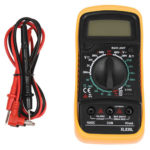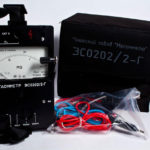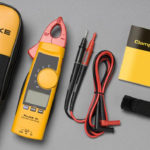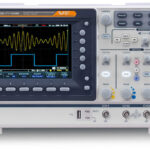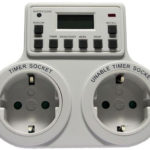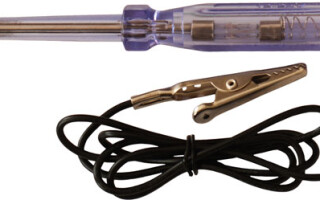If a malfunction occurs in the electrical wiring, calling a specialist is not always advisable, because the reason can be quite simple. Some breakdowns can be fixed on your own using a tool such as an indicator screwdriver. Useful in everyday life, the device is reliable and easy to use, capable of replacing expensive and complex tools. To check electricity, it is not necessary to be an electrician; with minimal knowledge in the field of power supply, you can use a screwdriver to determine the “phase” and “zero” wires.
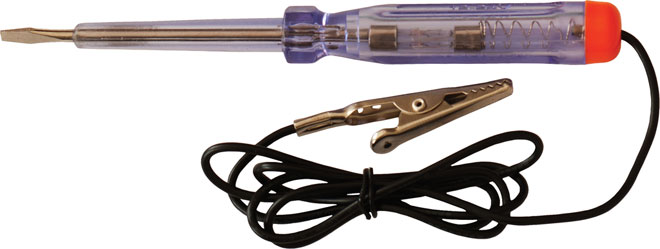
Content
The principle of operation of the indicator screwdriver
A universal indicator screwdriver accessible to any consumer is designed to detect the presence or absence of alternating voltage. Its main difference from a conventional screwdriver is the presence of a built-in indicator element in the cavity of the handle.The tip of the probe (probe) serves as a kind of conductor (contact part). Simple models are equipped with neon bulbs.
The principle of operation of a standard indicator screwdriver is based on conducting current through the tip (sting) and resistor to the contact of a neon or LED light bulb, as a result of which it lights up. If the device fails, it is necessary to replace the batteries or the tester itself (in case of a breakdown).
How does a universal indicator screwdriver work?
An important condition for the operation of the tester is the closure of the second contact located on the handle. To do this, touch the end part of the device (patch) with your finger (the body of the master serves as an element of the chain). Thanks to the built-in resistor, the current flowing through the tool is safe for the user.
A functional screwdriver, also called a voltage indicator, consists of several simple parts. The device of a standard indicator screwdriver looks like this:
- frame made of plastic (handle body);
- metal "sting";
- conductive contact and limiting resistor built into the housing;
- spring;
- neon or LED indicator;
- contact plate.
Varieties of indicator screwdrivers and their features
Modern indicator screwdrivers are divided depending on the type of construction and principle of operation. Thanks to a wide range of devices, users can choose a reliable and functional tool depending on financial capabilities, personal preferences (for home or professional use).
Types of indicator screwdrivers popular among users:
Standard fixture with neon light element - a simple contact type device. The bulb built into the probe glows when current passes through the tip of the screwdriver and the resistance resistor. The circuit is closed by pressing the “patch” with your finger (the contact plate at the end of the handle). The glow indicates the presence of a phase on the tested power source (wire, switch, socket or other electrical device). The disadvantage of this model is considered to be a rather high indication threshold - the device does not function at a voltage below 60V. An ordinary indicator-type screwdriver works without the use of batteries, it is intended only for detecting phase-zero, it is impossible to detect breaks in the circuit with its help.
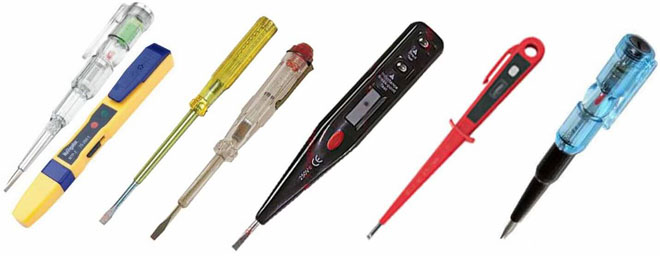
Devices with LED luminous element are similar in principle to the model with a neon bulb, but differ in a lower indication threshold (less than 60V). The tester operates from an independent power source (batteries). With the help of a multifunctional device equipped with a bipolar transistor, you can:
- determine phases;
- detect breaks in the network and places of damage in contacts;
- determine the polarity of various DC sources;
- using a non-contact method to identify the location of the cable in the wall (under the plaster);
- check the integrity of fuses and conductors.
Electronic device with liquid crystal or simple display often used as a mini multimeter. Universal screwdriver-indicator has a sound signal and compact dimensions. On the handle of the electronic device are located:
- display;
- function buttons;
- voltage indicator pointer;
- manufacturer's label.
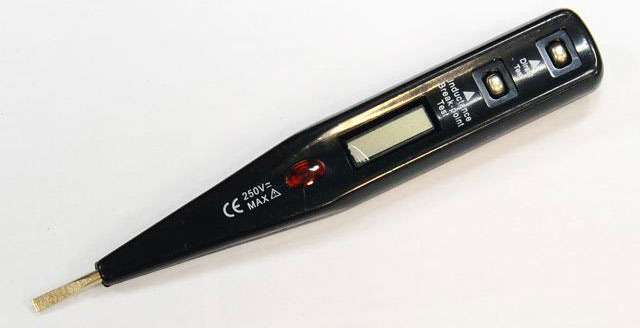
Advanced models are equipped with an inductive probe (sting). For consumers who do not know how to use the LCD indicator screwdriver, there are special operating instructions.
The electronic tester has the following applications:
- determination of the voltage level;
- integrity testing of various conductors, power lines, power networks;
- ground/phase detection;
- polarity check;
- determination of electromagnetic and microwave radiation.
In addition to the above functions, this indicator screwdriver is successfully used as a search detector, which allows you to detect hidden electrical wiring. Model with LCD display is multifunctional and high cost.
Application methods
The standard system of domestic houses is a single-phase network with two wires "zero" and "phase". To repair the wiring, it is necessary to identify the desired wire; for this, the voltage indicator is inserted into the socket or touched to the conductor under study. The presence of glow in the tester reveals the "phase", the absence - "zero".
To check the integrity of the light bulbs, it is best to use an indicator screwdriver with an LED. To do this, holding the light bulb by the base, it is necessary to attach the probe (sting) of the tool to its central contact. In this case, the finger touches the contact plate on the handle (patch). A glow or a sound signal indicates the operability of the lighting device.
In the same way, the integrity of the wire is checked, one end of which (stripped) is taken in one hand, and the other end is touched with the tip (probe) of a screwdriver. The glow indicates the integrity of the wire, the lack of reaction indicates a break in contact. In this case, there should be no voltage in the tested conductor.
Electronic devices do not require a person to touch the plate on the handle. To detect the presence of voltage, it is enough to touch the test object with the probe of the tester.
The working condition of the extension cord is checked as follows:
- the device is disconnected from electrical engineering and the network;
- insert any wire with stripped ends into its socket (contacts must be shorted);
- clamp one of the contacts and the plug in your hand, and touch the other with a voltage indicator;
- when the extension cord is working properly, the light starts to glow. Before connecting the equipment to the network, you must remove the jumper to avoid a short circuit in the wiring.
If the indicator does not respond, you should connect the extension cord to the network and slowly draw the tip of the handle (patch) of the tester along the entire length of the RCD (while the screwdriver is taken by the probe). In places of damage, the intensity of the indication decreases or there is no glow at all. To restore the working condition of the extension cord, insulation is removed in the detected break points, damage is found, the wires are twisted and insulated. The best option is to purchase a new electrical appliance.
The location of hidden wiring is determined by holding the back of the tester along the wall, holding it by the probe (sting). An increase in the intensity of the glow or the presence of a sound signal indicates the presence of conductive wiring behind the plaster.This method is considered insufficiently accurate, and in panel houses it is impractical.
How to use an indicator screwdriver
When working with the electrical network, you must follow the safety rules and know how to properly use the indicator tester. The main point is to turn off the package switches in electrical circuits when disassembling switches, sockets, etc. You should also make sure that the device is working, because the accuracy of the readings and the safety of the user (master) depend on its technical condition. The tool must have a whole body - without chips, cracks, and so on. If there is minimal damage, the device is replaced, since the consequences of an electric shock may be irreversible.
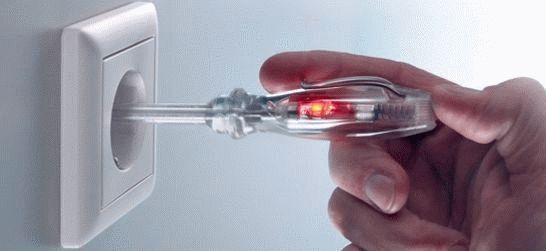
The working condition of the tester is checked by closing the circuit with your hands (by placing your fingers on the probe and the "heel" of the probe at the same time). The absence of glow occurs in two cases:
- when a device fails and needs to be replaced. Repair is not advisable, so the effort expended will be much more than the cost of a new tool.
- with dead batteries that need to be replaced with new cells. When installing them, pay attention to the polarity, otherwise the device will not function.
How to choose an indicator screwdriver
Before choosing a suitable indicator screwdriver, you should decide what it is for - for what kind of work (for home use or professional). Budget options are not inferior in quality to more expensive counterparts, but differ in a narrow set of functions. Indicator devices are sold in retail outlets, specialized departments and online stores.The cost of testers varies between 50-1500 rubles, depending on the technical characteristics, modification and manufacturer. Before choosing a suitable indicator screwdriver, it is advisable to read reviews and descriptions on the Internet. The following characteristics testify to the high quality of the tool:
- durable stainless steel rod;
- handle with a reliable dielectric surface;
- intact, no damage to the handle.
The scope of this device is wide, which makes a practical, easy-to-use device an invaluable assistant in simple electrical work. With all the useful indication properties, the tool does not cease to be a screwdriver, so some users use it when tightening fasteners.
Similar articles:

